
Invisalign® – Belmont, NH
Convenient and Discreet Orthodontic Treatment

Misaligned teeth are unsightly, but even more than that, they can pose a threat to your oral health. If your teeth are not in their proper positions, you should certainly take time to learn about the orthodontic treatments that are available to you. One popular teeth-straightening method is Invisalign® in Belmont, which spares patients from many of the hassles that come with traditional metal braces. The team at the Center for Contemporary Dentistry is proud to offer this remarkable and convenient treatment.
Why Choose the Center for Contemporary Dentistry for Invisalign®?
- On-staff orthodontist
- No metal brackets and wires
- Begin to see results within months
How Invisalign® Works

Whereas traditional braces use metal brackets and wires to apply gentle pressure to the teeth, Invisalign® uses a series of custom clear aligners to accomplish the same purpose. You wear each aligner for 20 – 22 hours each day for about two weeks before you move onto the next aligner in your series. Each aligner moves your teeth just a little, and when you have worked your way through your entire series, each of your teeth should be in its proper place.
Who Can Invisalign Help?

Invisalign is able to address most cases of mild to moderate dental misalignment. When you come in for your consultation, we will evaluate the positioning of your teeth and your dental health so we can determine for sure whether Invisalign is a good fit for your circumstances. We may also learn a bit about your general lifestyle and habits. Here are a few examples of orthodontic issues that Invisalign can often be used to correct:
Crowded Teeth

In addition to adversely affecting the aesthetics of your mouth, crowded teeth tend to trap food between them and are at a heightened risk of decay and breakage. They are also quite challenging to keep clean. Invisalign, along with possible extractions, can usually shift the teeth so they each have enough space to function well.
Gaps Between Teeth
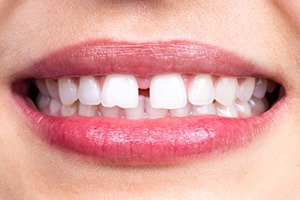
Gaps between the teeth are unsightly, and they may make you feel self-conscious about your appearance. Even more importantly, extra space between teeth leaves your gums vulnerable to damage. Invisalign may be able to move your teeth closer together, leading to a healthier and more aesthetically pleasing smile.
Overbite
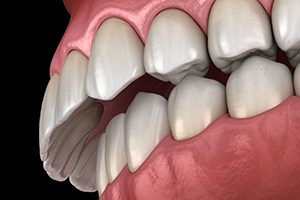
A slight overbite is both natural and normal, but if your top teeth rest too far in front of your bottom teeth, you may need a bite correction. Otherwise, you might suffer from speech issues, jaw pain, and other difficulties. Invisalign, usually along with special accessories, is often able to correct mild and moderate overbites.
Underbite
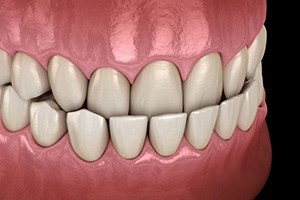
An underbite occurs when the bottom teeth rest in front of the top teeth. This can adversely affect facial aesthetics and endanger your oral health. You may be at a greater risk of dental damage, speech problems, and more. Invisalign, potentially with the help of rubber bands and other attachments, can correct many cases of underbite.
Crossbite

If only some of your bottom teeth rest in front of your top teeth, you have what is known as a crossbite. This issue is associated with an increased risk of broken teeth, speech problems, and other unpleasant challenges. Fortunately, Invisalign clear aligners are valuable for addressing many instances of crossbite.
Open Bite
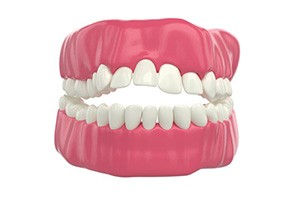
If there is a vertical gap between your upper and lower front teeth when your mouth is at rest, you have an open bite. This issue may adversely affect your ability to bite, chew, and speak with clarity. Invisalign is usually able to bring the top and bottom teeth together, effectively closing an open bite and improving oral function.
Benefits of Invisalign

Invisalign is a popular treatment because it offers a range of benefits that you simply cannot get with other orthodontic options, such as traditional metal braces. Its discreet appearance, overall convenience, and remarkable comfort are just a few of the perks it offers. What are some things that you can look forward to as an Invisalign patient? Continue reading below to find out. Hopefully, what you learn will help you feel more excited than ever about your upcoming treatment journey!
Discreet Aligners

Without a doubt, the discreet nature of Invisalign trays is one of this treatment’s biggest selling points. Although the aligners are not totally invisible, they are made out of clear plastic that does not call a lot of attention to itself. You will be able to smile with confidence in practically any social situation.
Improved Comfort

Invisalign aligner trays are made out of a smooth, patented type of plastic. The edges are carefully trimmed so they rest as comfortably as possible against your mouth’s soft oral tissues. Best of all, there are no metal brackets and wires that might irritate your tongue or cheeks.
Easier Dental Hygiene

With traditional braces, you must navigate around metal brackets and wires when brushing and flossing your teeth. You may even need to use special tools to clean the tight areas between your teeth. In contrast, Invisalign makes oral hygiene very easy. All you have to do is remove your aligners and brush and floss using normal techniques.
Quick Follow-Up Appointments

Invisalign check-ins are usually scheduled every 6 – 8 weeks or so, and they tend to be quite brief. In fact, many patients spend no more than 15 – 30 minutes in our office. During these appointments, we simply check on your progress, provide the next set of aligners in your series, and answer any questions that you may have.
Efficient Treatment

Did you know that the average treatment time with Invisalign is just 12 months? Of course, that can vary from case to case. Generally speaking, though, Invisalign is quite a bit faster than traditional metal braces, which may take 18 – 36 months for complete treatment. Efficient tooth movements with Invisalign could help you achieve your dream smile faster than you imagined!
Freedom to Eat Your Favorite Foods

Invisalign aligner trays are removable, so you do not have to worry about damaging them when you eat your favorite snacks and meals. As long as they are out of your mouth, you can enjoy whatever you are craving, including foods that are off-limits with traditional braces, such as popcorn, pizza crusts, and crunchy vegetables.
Living with Invisalign Aligners
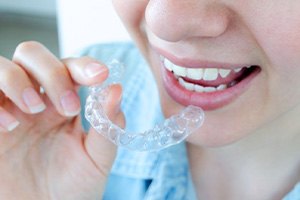
There is a lot to like about Invisalign. Indeed, one of its biggest selling points is that it is designed to fit in seamlessly with busy modern lifestyles. Of course, you will still need to make a few minor adjustments to your daily routine in order for your treatment to succeed. What exactly will you need to do? Our team can share detailed guidance when you get started with your aligners. In the meantime, here is a general overview of the best practices for living with Invisalign:
Wearing Your Trays

To make sure that your Invisalign aligners do their job, you will need to keep them in your mouth for 20 – 22 hours each day. Failing to meet this requirement could slow down your progress and make it difficult — or even impossible — for you to use successive aligners in your series. Make it your aim to only take your aligners out of your mouth when you eat, drink anything besides plain water, or care for your oral hygiene.
Cleaning Your Aligners

Maintaining the cleanliness of your aligners is crucial if you want to prevent unpleasant smells and discoloration, as well as safeguard your mouth against irritation. Rinse your trays thoroughly before reinserting them after each removal. Clean your aligners daily using a soft-bristled toothbrush and a gentle, clear soap. Always utilize cool or lukewarm water, since hot temperatures may deform the plastic. Regularly soaking your aligners in a recommended cleaning solution, such as Invisalign crystals, further enhances sanitation and freshness.
Eating & Drinking

Invisalign allows you to enjoy your favorite foods without severe restrictions, yet some adjustments to your eating habits can still be beneficial. It is important to remove your trays any time you eat or drink anything besides water, since food and colored beverages can stain or damage the aligners. To minimize frequent tray removal, strive to consume most of your calories at your main meals so you are not tempted to snack throughout the day. Always store your trays in a protective case during meals.
Losing or Damaging a Tray

If you misplace or break an aligner, reach out to our office promptly for guidance. We may recommend that you temporarily wear a previous tray to keep your teeth from shifting until we get a replacement for the one you can no longer use. Or, in some circumstances, we might advise you to advance to the next set of aligners. Do not switch to a new tray without professional approval, as moving ahead too quickly can lead to discomfort and disrupt your treatment process.
Routine Check-Ins

Regular appointments are an essential part of your Invisalign journey. We typically schedule check-ins every 4 – 8 weeks, with each visit lasting around 15 – 30 minutes. During these sessions, we will evaluate your progress, supply subsequent aligners, and address any questions or challenges you may have. Consistent follow-ups help to keep your treatment on track and allows us to provide ongoing support throughout the process.
Understanding the Cost of Invisalign

The cost of Invisalign® varies from case to case and depends largely on the number of aligners that each patient requires. When you visit us for your free consultation, we will examine your mouth and start planning your treatment. Then, we will be able to provide you with a cost estimate. We will also help you explore your payment options, potentially including insurance and financing. Plus, we often offer specials on Invisalign® to help our patients afford it.
Factors that Affect the Cost of Invisalign

Some of the main factors that affect the cost of Invisalign include:
- The number of aligners you require. This is the biggest thing that influences the price of Invisalign treatment. It is influenced by the severity of your dental misalignment and whether you are straightening one dental arch or both.
- The use of special accessories. Some patients require special attachments or other accessories for successful treatment. Logically, the use of such items can affect price.
- The length of your treatment. Shorter treatments may cost less than cases that require more time.
- Your compliance with treatment. If you carefully follow our instructions, you can minimize the risk of mishaps and avoid the additional costs they might incur.
Invisalign vs. Mail-Order Aligners: Which Costs More?
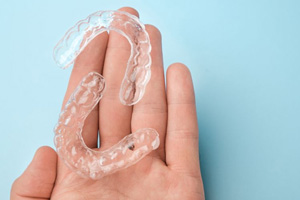
In recent years, mail-order clear aligner systems have gained some popularity. These treatments may seem appealing because they often cost around $2,000, whereas Invisalign can cost significantly more than that.
However, it is important to consider what you are getting for your money. Many patients have been dissatisfied with mail-order aligners. In fact, such systems even have the potential to worsen your dental misalignment. If that happens to you, you might end up spending more money to correct the issues caused by the mail-order treatment.
In contrast, with Invisalign, you get careful professional supervision as you straighten your teeth. We pay attention to the little details, can answer all your questions, and promptly address any issues that might arise. Additionally, the aligners are made of top-quality materials and carefully designed for your unique smile. Invisalign consistently provides desirable results.
Does Dental Insurance Cover Invisalign?

A handful of premium dental insurance plans apply to orthodontic treatment, so Invisalign is sometimes eligible for coverage. You will have to examine the details of your plan to find out if it will cover your treatment. Our team is insurance-friendly, and we can assist you with verifying your benefits and filing claims. With the help of their policy, some patients have been able to save hundreds of dollars or more out-of-pocket on Invisalign.
Options for Making Invisalign Affordable

Outside of dental insurance, other provisions that might help you afford Invisalign include:
- We are partnered with Sunbit and CareCredit, third-party companies that provide low-interest payment plans for qualified patients.
- We periodically offer special pricing for Invisalign patients. For example, you may be eligible for a FREE initial consultation.
- Essential Dental plan. This discount plan is designed for patients without insurance. It provides reduced fees on almost all the services available in our office.
Are you interested in learning more about Invisalign and its cost? Our Belmont team would be happy to answer your questions. Get in touch with us today!
Invisalign FAQs
If you are eager to straighten your teeth, our Belmont team is ready to assist you. When you attend your consultation, we will be pleased to answer all your questions. In the meantime, you might want to do some reading on your own to learn more about the path in front of you. Below, you will find answers to some relevant FAQs about Invisalign.
What Does Invisalign Look Like?
Invisalign is sometimes marketed as being “invisible,” but that is not quite accurate. When the aligners are on your teeth, they may make your teeth look a bit bigger than usual, and your teeth may seem like they have a film on them. However, your aligners are unlikely to be the first thing that other people notice about your smile.
Some patients require attachments for their Invisalign aligners. These attachments are not transparent. However, since they are usually placed toward the back of the mouth, there is no need to be too worried that they will ruin the aesthetics of your smile.
How Long Does Invisalign Take?
On average, Invisalign treatment takes 12 months. Of course, your case may require more or less time. If your dental misalignment is relatively simple and you comply with all treatment instructions, you might see final results in as little as 6 months or so. If your case is more complex, treatment could take 18 months or longer.
Even if your Invisalign will take a year or longer, you can expect the time to fly by. Plus, it is worth remembering that Invisalign usually takes significantly less time than traditional metal braces.
Does Invisalign Hurt?
Invisalign aligners are made of a patented plastic material that is designed to offer the right mix of durability and comfort. They have smooth edges that rest comfortably against the soft tissues in the mouth.
With that being said, it is worth mentioning that orthodontic treatment works because it applies continuous pressure to the teeth. As you may imagine, that can cause some discomfort, especially when you first start wearing an aligner. Taking painkillers and sipping on cool water can help you to get through the adjustment period. We also suggest that you start wearing a new aligner at night so you can sleep through your first several hours of wearing it.
What Happens After Invisalign?
After you have worked your way through all your aligners, our team will verify that your results are satisfactory. Then, we will provide you with a retainer. The purpose of a retainer is to hold your teeth in place so they do not drift back into their former positions.
At first, you may need to wear your retainer full-time (20 – 22 hours each day). Eventually, though, you might be able to wear it only at night. After several months, you may need to use it for just a few nights each week. If it ever starts to feel too tight, that is a sign you are not wearing it enough.